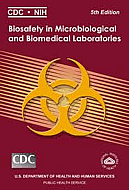
The BMBL, Biosafety in Microbiological and Biomedical Laboratories, and the NIH Guidelines for Research Involving Recombinant or Synthetic Nucleic Acid Molecules (NIH Guidelines) establish four risk groups for biological agents. These four risk groups address the risk to the laboratory worker, the environment, and the community.
Risk Group 1 agents are not associated with disease in healthy adults, Risk Group 2 agents are associated with human disease that is rarely serious and for which preventative or therapeutic interventions are often available, Risk Group 3 agents are associated with serious or lethal human disease for with preventative or therapeutic interventions may be available, and Risk Group 4 agents are likely to cause serious or lethal disease for which preventative or therapeutic interventions are not usually available. Risk Group 3 agents have high individual risk and low community risk, while Risk Group 4 agents have both high individual risk and high community risk.
The various factors that are reviewed in order to determine the risk group classification include the infectious dose of the organism, virulence, likely route on exposure, viability of the organism in the lab environment, host range, and availability of suitable disinfectants and prophylaxis. Be sure to review all relevant information when determining the appropriate risk groups for the biological agents in use at your facility.
